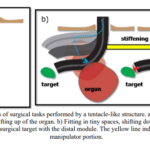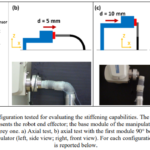A bioinspired soft manipulator for minimally invasive surgery
This paper introduces a novel, bioinspired manipulator for minimally invasive surgery (MIS). The manipulator is entirely composed of soft materials, and it has been designed to provide similar motion capabilities as the octopus’s arm in order to reach the surgical target while exploiting its whole length to actively interact with the biological structures. The manipulator is composed of two identical modules (each of them can be controlled independently) with multi-directional bending and stiffening capabilities, like an octopus arm. In the authors’ previous works, the design of the single module has been addressed. Here a two-module manipulator is presented, with the final aim of demonstrating the enhanced capabilities that such a structure can have in comparison with rigid surgical tools currently employed in MIS. The performances in terms of workspace, stiffening capabilities, and generated forces are characterized through experimental tests. The combination of stiffening capabilities and manipulation tasks is also addressed to confirm the manipulator potential employment in a real surgical scenario. Traditional surgical tasks imply the use of multiple specialized instruments such as graspers, retractors, vision system, dissectors etc. to carry out a single procedure. All these instruments need to be provided at the surgical site from different access points in the case of laparoscopy, or by using multifunctional instruments in the case of single access procedures. In particular, organ retraction is typically needed for shifting or lifting organs in order to generate the necessary space for passing through other instruments or for exposing the target organ. Retraction tasks can be rethought if the surgical manipulator belongs to this new kind of flexible structures. As an example, Figure 1a illustrates a simplified surgical scenario where, by means of the manipulator’s body itself, an organ (depicted in red) can be both lifted up and supported. Therefore by wrapping it and becoming stiffer (yellow line), the manipulator accomplishes the retraction task, which traditionally requires the insertion of additional instruments for moving and securing the organ away from the operative site. Furthermore, the shape of the manipulator would nicely enclose the organ, without resorting to the employment of clips and graspers which are traditionally used to retract organs during MIS. By means of the same strategy, other tasks such as squeezing into tiny spaces and approaching difficult-to reach anatomical districts can potentially be accomplished with a single manipulator. Referring to the scheme in Figure 1b, for gaining the necessary space for operating on the green target the manipulator must first slide into the tiny space left above the red organ, then shift and keep the red organ aside, and finally it can manipulate the target. The manipulator’s proximal portion has to become stiffer to serve as a stable base for the further manipulation tasks performed by the distal portion.
Learn about our two Decals!
 Click here to find out more about our Fall Bioinspired Design Decal and our Spring Bioinspired Design in Action Decal – ALL MAJORS are welcome.
Click here to find out more about our Fall Bioinspired Design Decal and our Spring Bioinspired Design in Action Decal – ALL MAJORS are welcome.Berkeley BioDesign Community
 Click here to learn about the BioD: Bio-Inspired Design @ Berkeley student organization or here to signup for more info.
Click here to learn about the BioD: Bio-Inspired Design @ Berkeley student organization or here to signup for more info.Search
Student Login






I imagine that the neurological circuits underlying these processes are governed by both 2d spacing maps with their brains as…
to reduce the impact of car accidents, it may be possible to study the force diverting physics of cockroaches to…
you see this type of head-bobbing stability in many avian creatures related to pigeons like chickens. the head ability to…
not like they taught horses how to run! this is an example of convergent evolution where both sea creatures and…
The brain functions in a similar way with neuronal connections. our brains are able to utilize the multiplicity of connections…